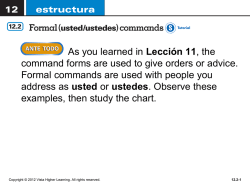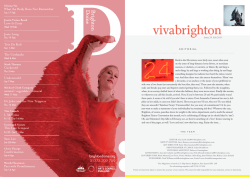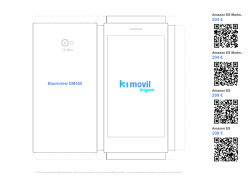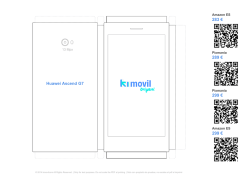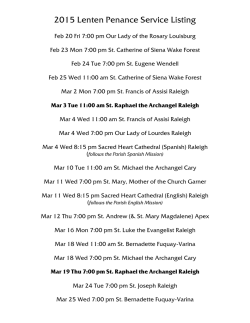
January 30, 2015 The last few months have been noteworthy for Mar
January 30, 2015 The last few months have been noteworthy for Mar Vista and our investors and we would like to highlight three key areas. First, the long-term outcomes of our process continue to align with the goals for our investors’ capital. Second, after accumulating a three-year track record, we are pleased to offer the Mar Vista Global Equity strategy. The product’s return and risk profile, albeit over a shorter three-year period, is similar to our other two domestic strategies: Strategic Growth and Focus. We welcome the opportunity to discuss the strategy with any investor that may have interest. And third, we completed our company transaction which more fully aligns the investment team’s interests with those of our clients. 2014 Outcomes In a decidedly challenging year for active managers, the Mar Vista Strategic Growth composite appreciated over 16% in 2014, besting the 13-14% returns for the large-cap benchmarks. More important than any one-year timeframe, we are achieving our longer term goal: to enhance the purchasing power of our investors’ capital at rates superior to those of passive benchmarks while incurring less risk. Cumulative Returns as of December 31, 2014 Net 1 Year 3 Years 5 Years 10 Years “Peak-to-Peak” R1000®G Alpha S&P 500® Alpha 16.3% 77.3% 93.7% 130.1% 13.1% 73.9% 108.3% 125.9% 4.10 2.92 0.29 1.87 13.7% 74.6% 105.1% 109.4% 1.69 0.11 -0.01 2.16 89.6% 76.0% 2.62 63.4% 3.22 * Peak-to-Peak represents returns generated January 1, 2008 through December 31, 2014. Mar Vista’s investment philosophy and process are built around the belief that capital preservation is equally important as appreciation. So while we are pleased to have generated excess returns over nearly every time horizon, we are equally proud to have achieved it with materially better down capture (71% and 78% versus the Russell 1000® Growth Index and S&P 500® Index, respectively) and lower beta (0.84 and 0.89, respectively) over the eleven years since our inception. A key driver for our performance in 2014 was the continued intrinsic value growth for our “compounding machines,” or wide-moat businesses that can reinvest excess capital at very high returns. We highlighted in last year’s letter four of our larger positions - American Tower, TransDigm, Liberty Global and Markel - which exemplified these traits. When adding two more of our top positions, Berkshire Hathaway and Honeywell, to that list of compounders, the group collectively returned 23% in 2014, well ahead of the market. We believe the returns from these types of businesses explain much of our alpha, not only in 2014, but over the last decade. The average margin of safety remains very low as price increases matched the growth of our portfolio’s intrinsic value. In fact, our current outlook for future returns remains exactly as we stated a year ago: As we have discussed in recent quarters, our average margin of safety, or upside to fair value, is currently less than 10%, the lowest since our inception. With this discount between current prices and fair values unusually compressed, we are often questioned about expected future returns. Admittedly, we don’t expect appreciation in the next five years to be anywhere close to [those] we’ve enjoyed over the last five years when the starting margin of safety was 76% and the economy and investor sentiment was moribund. From today’s prices, we would anticipate returns over our time horizon to more closely correlate with our companies’ per share intrinsic value growth (10%-12% average with a range of 7% to 20% assuming a stable economic environment) and only a modest return from the discounted price. In other words, the compounding nature of our businesses should provide the excess returns we expect in this type of environment. Ultimately, we want to incur risks that are less than commensurate with the returns generated. Extended valuations work two-fold against this objective: they increase the risk while lowering the expected returns. Only after this six-year bull market has been tamed will investors find out which managers generated excess returns via outsized risks. Even the most defensive, wide-moat compounder poses a higher risk of permanent capital loss if the price paid is excessive. As the saying goes, “time is the friend of the wonderful business” but if prices already reflect an unrealistic outcome, “quality” stocks will generate subpar returns. Judging not only by our proprietary margin of safety analysis, but also by several historic measures, the market is valued more dearly today than all but a few times in history: Total Market Value to GDP = 120%. Only two years in the last sixty has this ratio exceeded 120%: 1999 and 2000. Median P/E for US stocks = 20x. As compared to the market cap-weighted average that is widely quoted (17.5x) which isn’t far outside historical norms, the median price to earnings multiple for all NYSE US stocks exceeds 20x. This is the highest it has been in the post-war era, even exceeding the late 90’s. Price to 10-Year Average Inflation-Adjusted Earnings (Shiller P/E) = 27x. This trailing 10-year earnings ratio has only exceeded today’s level three times in history: 2007, ’99-’00 and 1929. We do not base our investment decisions on simple rules-of-thumb nor do we claim these levels are indicators of imminent corrections; the pendulum of over- and undervaluation can swing far beyond rationality particularly in a perverse environment with zero or negative interest rates. However, stretched valuations, lack of investor skepticism and the embracement of risk in the belief central banks will provide back stops all lead us to allocate your capital more prudently. In the current environment, our cash holdings have risen to the highest levels since 2007 and our positions are generally more concentrated in our high-conviction investments. The option value of cash is higher in these environments since capital is readily available when stocks dislocate. Changes to Our Portfolio Even in a fairly-to-overvalued market, the investment team stands ready to act quickly when the market presents us with skewed payoffs relative to the odds. For example, one day in mid-October, in the midst of the Ebola scare and European weakness, we quickly deployed cash into two existing holdings, Allergan and Visa, and initiated a new position in O’Reilly Automotive. The good news is all three investments appreciated 20-30% by the end of the quarter; the bad news for future returns is they are all now trading close to fair value. We also initiated a new position in Amazon during the quarter. Amazon (AMZN) We twiddled our thumbs for a mere decade waiting for an appropriate margin safety for Amazon. After underperforming the market by more than 30%, Amazon’s stock finally had a large enough discount to warrant an investment. The company’s economic moat is centered on its low-cost eCommerce infrastructure and the network effect from over 270 million active users. Relative to more capital-intensive brick-and-mortar retailers, Amazon’s recurring online traffic provides a significant cost advantage and superior returns on capital. The moat is perpetuated as lower prices, robust inventory selection and affordable home delivery provide value to the consumer driving further market share gains and scale advantages. Nearly every traditional valuation metric, like earnings or free cash flow multiples, would suggest we vastly overpaid for Amazon’s business. However, through the lens of our more holistic framework that assesses the magnitude and durability of excess economic rents, we think Amazon was a bargain. Our variant perception versus the market on this widely covered name was twofold. First, Amazon’s financials do not adequately reflect the value created from the most important evolution of Amazon's business model: the rapid growth of third party sales. Today, third party transactions account for over 40% of units sold on Amazon’s website. Only the commissions received from this business are booked in revenue, but if we adjust them to to reflect the gross value, as other retailers do, the valuation looks rather cheap. Second, investors punished Amazon for excessive spending on a multitude of unprofitable ventures, namely cloud infrastructure, digital media content and the Fire smartphone. With our longer time horizon and confidence in Jeff Bezos’ moat-expanding capital allocation decisions, we believe Amazon will deliver returns well above their cost of capital on these investments. If not, we expect Mr. Bezos will moderate the capital spending and focus on higher returning projects. Our base scenarios for estimating intrinsic value only require Amazon to maintain its industry leading 20% share of the U.S. eCommerce market while online spending also grows as a percentage of total retail sales. By our math, increased eCommerce penetration will drive Amazon’s 3% share of total U.S. retail sales closer to Walmart’s 9% over the next decade while operating margins return to their previous 6% peak. Combined with a less intense capital investment cycle, returns on capital and economic value creation skyrocket. O’Reilly Automotive (ORLY) O’Reilly is an aftermarket auto parts retailer and supplier that focuses on both the commercial and retail (or “DIY”) segments of the automotive service industry. ORLY has built a moat around its “Hub Store” distribution network, which can deliver parts daily to over 85% of its store base. Since the company maintains 50% fewer stores per distribution center compared to the competition, inventory turns are quicker and product offerings are broader and more readily available. In turn, the superior customer experience drives market share gains and healthier returns on capital. Any company that has an average tenure of more than thirty years for the senior executive team must be doing something right. We have been consistently impressed with CEO Greg Henslee and his team’s continuous investments in building the depth and durability of O’Reilly’s moat. They think and act like true Outsiders. We believe the company has a long runway for real estate expansion and operating improvements. O’Reilly’s 4,200 stores represent only a 6% share of the highly fragmented aftermarket auto parts industry and they have the opportunity to grow the store base by 40% to 6,000 stores over the next decade. The company should deliver per share intrinsic value growth of 12-15%, assuming 4-5% store growth, 3-5% same-store sales growth, 9-11% operating profit growth, and 3-4% stock repurchases. Introducing the Mar Vista Global Equity Strategy Three years ago, we invested partner capital in a new Global Equity strategy which leveraged our existing universe of widemoat businesses but emphasized companies whose stocks weren’t exclusively traded on U.S. exchanges. The case for global diversification is well known and the location of a company’s headquarters is less relevant to an investment than the geographic mix of revenue and profits. Often, valuation disconnects from economic reality simply due to the local exchange upon which the stock trades. Global Equity is a concentrated strategy (with 20 to 25 positions) where we apply the exact same philosophy and process as with our domestic strategies. The outcomes over the last three years have aligned with the goals of our process: excess returns with less risk. Cumulative Annualized Down Up ITD* Alpha Beta Capture Capture MVIP Global Equity (Net) 51.7% 3.95 0.76 51.7% 94.1% MSCI All Country World Index Net 48.5% *Inception 12/31/11 Update on Mar Vista’s Ownership Structure In addition to a solid investment framework, we believe that a common attribute of successful, multi-generational investment firms is full control and ownership by the investment team. Economic incentives drive behavior and a simple, fully aligned structure connects the investment team’s decision-making to the long-term objectives of the clients. Therefore, it was with great excitement that on November 20th, we announced a transaction that extinguished the equity interests of our partner, Roxbury Capital Management, leaving the four partners of Mar Vista as sole shareholders of the firm. At the same time, Mar Vista, along with Hood River Capital Management, jointly acquired the operations of Roxbury. They will continue to provide all of our non-investment related services, including trading, operations and client service, just as they did prior to the transactions. We are pleased to announce that on January 20th, the two transactions closed. To have our interests completely aligned with the interests of our clients is an important milestone and critical for Mar Vista’s long-term success. Despite the positive change in the ownership structure, all of the day-to-day functions of our team, as well as that of Roxbury’s operations team, remain the same. The four partners in Los Angeles will continue to research and evaluate businesses, while the Roxbury team in Minneapolis will continue to provide our clients with world-class operational services. Our Commitment to Our Investors Though there are never guarantees in investing results, the Mar Vista team remains committed to the foundations of our success: Focus on the process, not the outcomes Emphasize capital protection as much as upside potential Think like rational business analysts first, not traders of individual stock Identify good capital allocators that think and act like Outsiders Exploit the manic-depressive nature of Wall Street Take concentrated positions when the expected returns relative to the risks are favorable Align our economic incentives with our investors As always, we appreciate the trust you have instilled in us as stewards of your capital. Our role as fiduciary is paramount to everything we do and open communication about how we are managing your capital is an important part of that responsibility. Please let us know of any questions, comments or concerns you may have. We look forward to the opportunity to discuss our investment philosophy and thoughts with you through these updates, conference calls and personal meetings. You can reach us by phone at 310.917.2800, via email at [email protected] or visit our website at www.marvistainvestments.com. All the best, The Mar Vista Investment Team Mar Vista Investment Partners, LLC (“Mar Vista”) is an investment adviser registered with the SEC. Performance presentations compliant with the requirements of GIPS® standards can be obtained by calling 800-993-1070. Mar Vista claims compliance with the Global Investment Performance Standards (GIPS). On 7/12/07, Silas Myers and Brian Massey formed Mar Vista to manage various large-cap equity strategies. On 12/1/07, all of the assets under their management at Roxbury transitioned to Mar Vista through a sub-advisory arrangement. Information provided for the period from January 2004 through November 2007 represents the performance of portfolios managed by Mr. Myers and Mr. Massey while employed by Roxbury. Mar Vista has been independently verified for the periods 12/01/07 through 12/31/14. The Strategic Growth composite has been examined for the periods 12/31/03 through 12/31/14. The verification and performance examination reports are available upon request. For the entire period presented, Mr. Myers and Mr. Massey have been substantially responsible for the all the investment decisions of the large-cap equity strategies. Performance prior to 12/01/07 meets GIPS® portability requirements. The Strategic Growth Composite was created 12/01/07, with an inception date of 12/31/03. All returns are based in U.S. dollars and are computed using a time-weighted total rate of return. The composite is defined to include all fully discretionary, fee paying portfolios with no minimum or maximum account value, managed in accordance with Mar Vista’s Strategic Growth strategy, and that paid for execution on a transaction basis. Prior to 1/01/06, the composite was defined to include only taxable portfolios with no minimum or maximum value. One non-fee paying portfolio is included in the composite for the following periods: 0.2% of the composite’s assets for year end 2008; 0.1% of the composite’s assets for 2009; and 0.1% of the composite’s assets for 2010; and 0.1% of the composite’s assets for the period ending 9/30/11. Beginning 10/1/11 there are no longer any non-fee paying accounts in the composite. The results in the column marked Net of Fees for the periods 8/01/08 through the present, include a standard management fee applied to any non-fee paying portfolio for performance calculation purposes. The primary benchmark is the Russell 1000 ® Growth Index, defined as an unmanaged, capitalization weighted index of those Russell 1000® companies with higher price-to-book ratios and higher forecasted growth values. The secondary benchmark is the S&P 500® Index, defined as an unmanaged, capitalization weighted index of the common stocks of 500 major U.S. corporations. Index returns include dividends and/or interest income and, unlike composite returns, do not reflect fees or expenses. In addition, unlike the composite, which periodically maintains a significant cash position, the Russell 1000® Growth Index and the S&P 500® Index are fully invested. The Global Equity composite was created in 2012, with an inception date of 12/31/11. All returns are based in U.S. dollars and are computed using a time-weighted total rate of return. The composite is defined to include all fully discretionary, fee paying, taxable and tax-exempt portfolios with no minimum or maximum account value, managed for at least one month in accordance with Mar Vista’s Global Equity strategy, which is a portfolio invested in 15-30 equities, and that paid for execution on a transaction basis. The benchmark is the MSCI® All Country World Index. Two non-fee paying portfolios are included in the composite for the following periods: 100% of the composite’s assets for 2012; 100% of the composite’s assets for 2013; 87% of the composite’s assets for 2014. The results in the column marked Net of Fees for the periods 1/01/12 through the present, include a standard management fee applied to any non-fee paying portfolio for performance calculation purposes. The benchmark is the MSCI ACWI Index, defined as a free float-adjusted market capitalization weighted index that is designed to measure the equity market performance of developed and emerging markets. The MSCI ACWI consists of 45 country indices comprising 24 developed and 21 emerging market country indices. In addition, unlike the composite, which periodically maintains a cash position, the MSCI ACWI ® Index is fully invested. Investors cannot directly invest in an index. Investors cannot directly invest in an index. Net performance is net of any applicable performance fees and net of transaction costs and actual management fees, but before any custodial fees. All returns are calculated net of withholding taxes on dividends and interest. Actual results may differ from composite results depending upon the size of the portfolio, investment objectives and restrictions, the amount of transaction and related costs, the inception date of the portfolio and other factors. Policies for valuing portfolios, calculating performance, and preparing compliant presentations are available upon request. A complete list of portfolio holdings and specific securities transactions for the investment strategy during the preceding 12 months, the top contributors and underperformers calculation methodology and a list of every holding’s contribution to the overall performance during the period is available upon request. The securities mentioned in this letter were held in the account of a Strategic Growth client that Mar Vista believes to be representative of the accounts that Mar Vista manages for this investment strategy during the period from September 30, 2014-December 31, 2014. Other Mar Vista clients managed with different investment objectives may hold different securities than those listed. The securities listed in this letter should not be considered a recommendation to purchase or sell any particular security. The reader should not assume that investments in the specific securities identified herein were or will be profitable. Risk data is being provided as supplemental to the Strategic Growth GIPS performance presentation, which is available upon request. Past performance is no guarantee of future results. Not FDIC insured, no bank guarantee, may lose value.
© Copyright 2026
